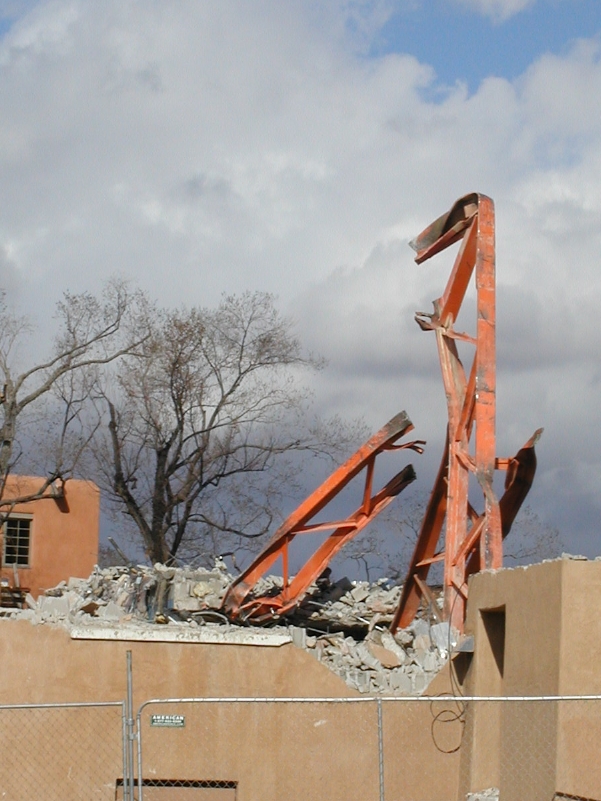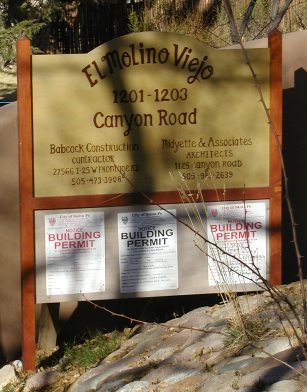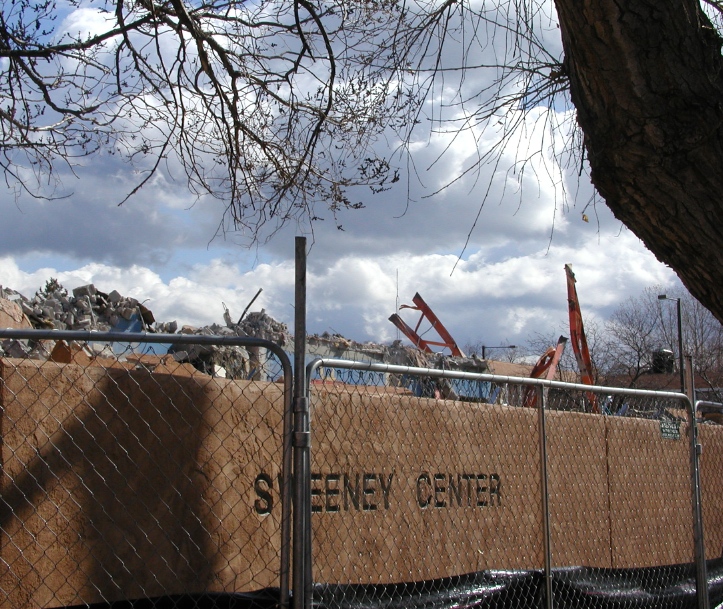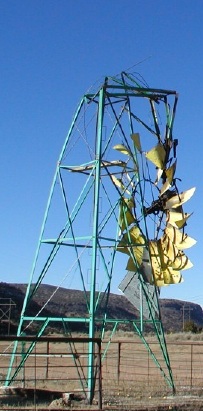

copyright 2006 by George Johnson

Sweeneysaurus Rex. photos by George Johnson, copyright 2006
1. Retrofit Arithmetic (and Rainbarrel Economics)
2. The San Juan-Chama Shell Game
3. The Case of the Disappearing Aquifer
4. The Creative Hydrology of Suerte del Sur
5. The City, the County, and a Water Tax Revolt
6. Water Numerology at City Hall
(Our story thus far)
7. The Woman at Otowi Gauge
8. "Forget it, Jake. It's Chinatown."
9. The Las Campanas Connection . . . desalination word games . . . and Aamodt South
(Our story continues)
10. The Engineering Solution
11. The Sorrows of San Acacio
12. The City's Dubious Water Report
13. Where the Water Went
14. Shutting Down the River Again
15. Picking on the Davises
16. The Tom Ford Webcam
17. Galen Buller's Day Off
18. Forgive and Forget
19. Election Postmortem
20. El Molino Gigante
21. Hotel Santa Fe. . . Mansion Watch . . . Water Watch
April 3, 2006
20. El Molino Gigante
Sitting at the very end of East Alameda, where it intersects Canyon Road, the Senutovich estate was a reminder of friendlier times. Neighbors out for a walk along the river were welcome to wander through the open meadow, admiring the cottonwoods and imagining a time when the property was the site of an old grain mill.
Then several years ago the estate was put on the market and the transformation began. The "For Sale" sign soon gave way to a "No Trespassing" sign and then a fancy wooden placard informing passersby that the place was now to be known, rather grandly, as El Molino Viejo, The Old Mill. The red-and-white building permits were posted along with the name of the architect, John T. Midyette, who had been commissioned by William C. and Susan Follet Morris to build an 8,590-square-foot, two-story house.  What had been the Senutovich residence would become the guest house, the old guest house would become the caretaker's quarters, and residents of the modest homes along Camino Pequeño, the narrow dirt lane that runs along the opposite bank of the river, would get illustrious new neighbors. Mr. Morris is the president and chief executive officer of the Metropolitan Opera. Mrs. Morris is president of the Santa Fe Opera.
What had been the Senutovich residence would become the guest house, the old guest house would become the caretaker's quarters, and residents of the modest homes along Camino Pequeño, the narrow dirt lane that runs along the opposite bank of the river, would get illustrious new neighbors. Mr. Morris is the president and chief executive officer of the Metropolitan Opera. Mrs. Morris is president of the Santa Fe Opera.
 Hidden among the trees, the house that has since arisen is beyond the reach of my webcam. Maybe Mr. Ford can see it from his hill. During construction, however, I had a good view of the cranes, and as they piled the adobes higher and higher, some of the people on Pequeño wondered when they were going to stop. Recently one of them took out his tape measure, and so the saga began. The house topped out at more than six feet higher than what is apparently allowed by the building code.
Hidden among the trees, the house that has since arisen is beyond the reach of my webcam. Maybe Mr. Ford can see it from his hill. During construction, however, I had a good view of the cranes, and as they piled the adobes higher and higher, some of the people on Pequeño wondered when they were going to stop. Recently one of them took out his tape measure, and so the saga began. The house topped out at more than six feet higher than what is apparently allowed by the building code.
The story of how this happened is a tragicomedy of errors and misunderstandings. In the historic districts, the maximum permissible height for a new structure is gauged by taking the average elevation of nearby buildings. Plugging the numbers into the formula, a staff member for the Historic Design Review Board came up with 14 feet 8 inches, and, as was customary, added two more feet to allow for measuring mistakes. That practice has since been recognized as improper -- why not subtract two feet for errors? -- and has been discontinued, but the result was to give the Morrises a little more headroom.
From there the errors piled higher. When a lot slopes downward, the Historic Board has the discretion of allowing up to four additional feet in the form of "stepbacks," higher parts of a building that rise behind the facade that is closest to the street. The Morris property indeed sits below Canyon Road, but the house the architect designed fronts along a different public right of way, the river, sitting slightly above it. From that vantage point, there is no downward slope. Stepbacks would only make the house more imposing -- the opposite of what the code intends. Nevertheless, for reasons that remain obscure, the Historic Board voted to approve plans for a structure described as standing 16' 8" in front but with other sections rising as high as 20 feet.
And that still wasn't the end of it. In the final plans submitted by the architect, the highest part of the house had grown to 20' 8." The building permit was approved anyway, and by the time construction was nearly complete even that level had been exceeded. The mansion now looms 23 feet above the river, far higher and more massive than any other house around. Yesterday, I walked down Camino Pequeño and took this picture.
Twelve years ago, when the builder of a house on Cañada Ancha, off Hyde Park Road, exceeded the height stipulated on his building permit, he was ordered by City Council to cut three feet off the top. That won't be happening this time. Ann McLaughlin, the director of the city planning and land use department has determined that El Molino Viejo "substantially conforms with what was approved," an opinion the neighbors must find puzzling but have decided not to appeal. At last report they were negotiating with the Morrises over a request to screen the house with more trees. Giant Sequoias might do the trick.
April 14, 2006
Hotel Santa Fe
When the California State Court of Appeals ruled in favor of the city of Carmel's long-standing ban on transient vacation rentals, it cut to the heart of a matter that is now playing out in Santa Fe:
"It stands to reason that the 'residential character' of a neighborhood is threatened when a significant number of homes . . . are occupied not by permanent residents but by a stream of tenants staying a weekend, a week, or even 29 days ... such rentals undoubtedly affect the essential character of a neighborhood and the stability of a community. Short-term tenants have little interest in public agencies or in the welfare of the citizenry. They do not participate in local government, coach little league, or join the hospital guild. They do not lead a scout troop, volunteer at the library, or keep an eye on an elderly neighbor. Literally, they are here today and gone tomorrow -- without engaging in the sort of activities that weld and strengthen a community." (Ewing v. City of Carmel-by-the-Sea, 286 Cal. Rptr. 382 (Cal. Dist. Ct. App. 1991).
Key West, Florida's strict ban on vacation rentals has also been upheld in a higher state court, and a morning spent perusing the Web shows that resort towns all over the country have initiated similar ordinances, restricting rentals in residential neighborhoods to at least 30 and sometimes even 180 days.
In Santa Fe we like to do things differently. Though there is a law on the books similar to Carmel's, enforcement has been so lacking that an illegal industry has flourished with companies like The Management Group, Kokopelli, and VeneKlasen Property Management openly aiding and abetting breakers of the law. For a piece of the action, the agencies advertise the wildcat rentals on the Web, provide maid service, maintenance and the equivalent of a hotel front desk, treating residential neighborhoods as though they were commercial zones. In some cases the problem has become so annoying -- traffic, noise, litter -- that people have begun complaining, and the city responds, Santa Fe style, by appointing two operators of the illicit enterprises to a task force to study the situation.
It has become clear from the hearings what a lucrative business this has become. The issue is not people occasionally renting their homes for a couple of weeks while they travel, but investors who buy up single-family houses for the express purpose of turning them into unregulated hotel rooms. Unlike legitimate hoteliers, the unlicensed innkeepers aren't compelled to provide off-street parking, obey occupancy restrictions, or subject themselves to regular fire safety inspections. They don't even pay the city hospitality and sales taxes.
According to a story in today's New Mexican, 25 percent of the houses on a narrow dirt street called Johnson Lane have been turned into illegal rent-by-the-day bungalows. With a few more conversions the street may pass the tipping point, with other neighborhoods following domino-style. The wave of new hotel rooms, time-shared "residence clubs," and condominiums proliferating around the Plaza will radiate outward along Canyon, Acequia Madre, Palace, Aqua Fria, Otero, and Galisteo. The tourists coming for the real Santa Fe experience the agencies are selling might find that there is no one to mingle with but other tourists, wandering the streets of what used to be a real, live town.
Meanwhile, the people profiting at the expense of their neighbors portray themselves as the aggrieved party. "No one has yet given me an answer as to why this is happening," a representative of the Management Group said at a public hearing yesterday. "Why is the city targeting us? Why is the city taking our lives to task? I am offended that we're constantly being called illegal."
She might well have added, "Even though we are."


April 18, 2006
Mansion Watch
Construction continues atop Mount Davis with two large cranes chomping away. Click the photo below for a live view. (I have put a 2X extender ring on the 50mm lens, which gives a closer look but with a slight loss of resolution.)
photo of Davis mansion by Kirsty Stebbins, 4/15/06

April 26, 2006
 The curious case of El Molino Gigante, or Eldorado II, as some residents of Camino Pequeño are calling it, may not be over yet. Two neighbors who have scrutinized the final construction drawings report that El Gigante's footprint is actually 10,750 square feet -- 2,160 more than what the Historic Board was asked to approve. If so, the extra floor space amounts to the size of an average three-bedroom house. Counting both stories, the total walled area came to 12,960 square feet, not including 4,280 square feet of portals. Based on all that, the neighbors have appealed the decision by the city Planning and Land Use Department to grant a certificate of occupancy and allow the Morrises to move in.
The curious case of El Molino Gigante, or Eldorado II, as some residents of Camino Pequeño are calling it, may not be over yet. Two neighbors who have scrutinized the final construction drawings report that El Gigante's footprint is actually 10,750 square feet -- 2,160 more than what the Historic Board was asked to approve. If so, the extra floor space amounts to the size of an average three-bedroom house. Counting both stories, the total walled area came to 12,960 square feet, not including 4,280 square feet of portals. Based on all that, the neighbors have appealed the decision by the city Planning and Land Use Department to grant a certificate of occupancy and allow the Morrises to move in.
Another possible point of contention is the construction cost listed on the building permit: $1,200,000. That would come to $93 a square foot ($70 if you count the verandas), a fraction of the going rate for luxury building in Santa Fe. The same issue came up last year with the Davis mansion. Since the city calculates its impact fees based on a percentage of total cost, any discrepancies may be of interest to the new regime at City Hall.
It is unclear whose desk this mess will land on. Anne McLaughlin, who as director of Planning signed off on El Gigante, has been shuffled to a job in Parks and Recreation -- part of an overhaul of what Mayor Coss called a "dysfunctional" department. In an editorial, the New Mexican was even harsher:
There's too little long-range planning and too much emphasis on approving land use and misuse, especially for wheeler-dealers with friends in high places -- and making the process long and hard for those people with minor projects who do follow the rules.
Meanwhile here on the southern flank, the Tom Ford mansion remains in limbo, awaiting the outcome of a neighborhood association appeal. The piñones seem to be sprouting nicely.
Water Watch
May 22, 2006
Two Sundays ago, with some 300 gallons of water sitting in my rain barrels from the unexpected May showers, I drove to Home Depot to buy half a dozen bags of cedar mulch and some drip irrigation parts. Steering my overloaded cart through a crowd of shoppers buying flats of pansies, petunias, and marigolds, I might have been in Tacoma, Washington or Terre Haute, Indiana -- almost anywhere but Santa Fe, which has just gone through the driest winter and spring in more than a century. Never mind the seemingly endless drought. With the danger of frost behind us, spring planting season has begun.
The scene was even madder at Santa Fe Greenhouses. I'd meant just to buy some fertilizer but couldn't resist browsing the picked-over aisles of penstemons, salvias, and other xerics, coming away with half a dozen thyme plants to replace some that had died this year. At least, I told myself, I'd be starting them on rainwater. But I have other plants, all reasonably drought tolerant, that require help from the city water mains. Like so many others, I've lost thousands of dollars of landscaping in recent years -- including a Russian olive and bristle cone pine planted more than a decade ago.
I do my best to save water. I have retrofitted the toilets, installed shower head shutoffs and a hot-water recirculation line. Paper plates (recycled) have replaced glass for two meals of the day. But I am not going to let my yard turn to dust so that the city can keep approving more subdivisions and shopping centers.
A look at the latest report on water consumption suggests that most people feel that way. For the week ending May 14, Santa Feans consumed 11.85 million gallons a day -- the most since 2001, before the retrofitting ordinance was passed.
Week ending May 14 Total consumption/demand in millions of gallons per day 2006 11.85 2005 9.55 2004 11.52 2003 10.89 2002 11.73 2001 12.46
With June approaching, the situation will only get worse. The forests will be closed, we'll be moved to Stage 3 water restrictions, and barring a seismic change in policy, City Hall will keep on approving more construction.
Postscript, May 31, 2006
Before turning the page on this upside-down blog and moving on to part 22, here for the record are some updates.
Santa Fe's water consumption continues to break five-year records. During the last week of May we used an average of 12.81 million gallons a day, the most since 2001. With a mere 760,000 gallons flowing daily into the reservoirs, they are down to 58 percent and falling, while the dessicated bosque is becoming a tinderbox.
Meanwhile the agenda for tomorrow's planning commission meeting includes a request for final approval of an 85,000 square-foot commercial development, Colores Plaza, the core of what is to be a 300-house subdivision, and for the rezoning of part of Old Taos Highway to accommodate a high-density condominium development. In addition, a real estate speculator is asking that his Eastside lot be rezoned from R-1 to R-2 (two residences per acre), threatening a domino effect that could lead to almost doubling the number of potential building sites on the southside of upper Canyon Road.
The Archdiocese continues to play hardball, insisting on a divine right to erect a six-acre, three-story development atop Bishop Lamy's paved-over gardens, and on Mount Davis an enormous new wing has sprouted on a home that will have half an acre of floor space.
Tonight's predicted thunderstorm turned out to be just the usual clouds and lightning. No one, at City Hall or higher, appears to be in charge.

Coming Soon: The Environmental Impact of Jennifer Jenkins
The Andrew and Sydney Davis Webcam
The Santa Fe Review

If you would like to be on the email list (or wish to be deleted), please write to the above address.
More links:
See the current flow of the Santa Fe River above McClure Reservoir with the USGS automated gauge.
The Otowi gauge shows the flow of the Rio Grande north of Santa Fe.
Santa Fe water information, a collection of documents and links